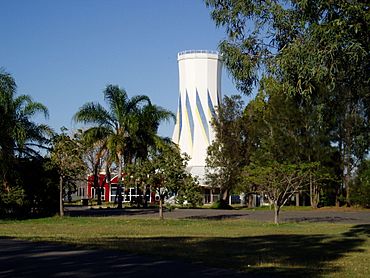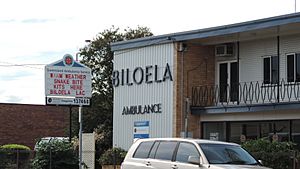Biloela facts for kids
Quick facts for kids BiloelaQueensland |
|||||||||||||||
|---|---|---|---|---|---|---|---|---|---|---|---|---|---|---|---|

The Silo, Biloela
|
|||||||||||||||
| Population | 5,692 (2021 census) | ||||||||||||||
| • Density | 323.4/km2 (838/sq mi) | ||||||||||||||
| Established | 1924 | ||||||||||||||
| Postcode(s) | 4715 | ||||||||||||||
| Elevation | 175 m (574 ft) | ||||||||||||||
| Area | 17.6 km2 (6.8 sq mi) | ||||||||||||||
| Time zone | AEST (UTC+10:00) | ||||||||||||||
| Location |
|
||||||||||||||
| LGA(s) | Shire of Banana | ||||||||||||||
| State electorate(s) | Callide | ||||||||||||||
| Federal Division(s) | Flynn | ||||||||||||||
|
|||||||||||||||
|
|||||||||||||||
Biloela is a country town in Central Queensland, Australia. It's the main town for the Shire of Banana. In 2021, about 5,692 people lived here.
Contents
- Discover Biloela: Location and People
- History of Biloela
- Heritage Sites
- Climate in Biloela
- What Biloela Does: Industries
- Dinosaurs in Biloela
- Callide Dam
- Education in Biloela
- Amenities and Services
- Fun Events in Biloela
- Sports and Recreation
- Media and News
- The "Biloela Family"
- Sister City
- Images for kids
Discover Biloela: Location and People
Biloela is about 120 kilometers (75 miles) inland from the port city of Gladstone. It sits where the Burnett and Dawson highways meet. The Shire of Banana is quite large, covering about 28,610 square kilometers (11,050 sq mi).
In 2016, Biloela had a population of 5,758 people. By 2021, this number was 5,692 people.
History of Biloela
Early Aboriginal History
The town of Biloela was built on the traditional lands of the Gangulu people. Their language is called Gangalu. This language region includes towns like Clermont and Springsure. It also reaches south towards the Dawson River.
The Gangulu people had a special ceremonial place called a bora ground near where the main street of Biloela is today. They had a unique custom for burying their dead. They would place skeletal remains in hollowed-out trees. These trees were marked with red ochre. Dingoes helped them hunt kangaroos and emus for food.
The Prairie Property
British settlement in the area started in 1854. Frederick Morton set up a large farming property called Prairie. This property covered about 500 square miles in the Callide valley. Morton built his home close to where Biloela is now. He first raised sheep, then later cattle.
In 1864, Morton and other settlers attacked an Aboriginal camp. They were looking for people who had taken some sheep. The Aboriginal people knew they were coming and set up a trap. Morton's group either got a warning or were pushed back. They had to retreat.
Later, in 1873, a group called the Native Police was accused of harming Aboriginal people. An investigation found that a Native Police officer had shot an Aboriginal man. This man was trying to escape arrest. The officer was cleared of wrongdoing. Local settlers even asked him to do more patrols. An Aboriginal survivor named Etamitcham later said his family was chased over the Kroombit Mountains. They ran to avoid being shot. Aboriginal people worked on Prairie Station. They were paid with small items and tobacco.
In 1886, most of the Prairie land was divided and sold. What was left was bought by Montague Beak. In 1925, the government took back the land. It was then divided into smaller plots for town development.
Founding of Biloela Town
The name Biloela is thought to come from an Aboriginal word for cockatoo. This word might have come from the Sydney area. For example, the Government dockyards in Sydney were called Biloela from 1871 to 1913.
The town of Biloela officially became a town in 1924. It was located on the Rannes-Monto railway line. Land was sold in Rannes in December 1924. The Biloela Post Office opened in January 1925.
Biloela Provisional School opened on June 22, 1925. It became Biloela State School in 1928. A special education unit started in 1979. A secondary department opened in 1957. This closed when Biloela State High School opened in 1963.
Callide Bridge State School opened in 1929. It changed names a few times before becoming Raedon State School. It closed in 1959. St Joseph's Catholic Primary School opened in 1939. It was run by the Sisters of Mercy until 1980.
The first open-cut mine in the area started in 1942. Work on the Callide Power Station began in 1963.
Heritage Sites
Biloela has some important historical sites. These are places that are protected because of their history.
- 48 Gladstone Road: Greycliffe Homestead
Climate in Biloela
Biloela has a humid subtropical climate. This means it has hot, wet summers and mild, dry winters. Nights in winter can be cool.
The average high temperature is 33.2°C (91.8°F) in January. It drops to 21.9°C (71.4°F) in July. The average low temperature is 19.8°C (67.6°F) in January. It can go down to 5.2°C (41.4°F) in July.
Biloela gets about 683.9 mm (26.9 inches) of rain each year. Most of this rain falls during the summer. It rains on about 55 days a year. The hottest temperature ever recorded was 44.0°C (111.2°F) in November 1990. The coldest was -4.3°C (24.3°F) in July 1965.
The Thangool Airport is about 13.8 km (8.6 miles) southeast of Biloela. Weather records have been kept there since 1929.
What Biloela Does: Industries
Biloela and the Banana Shire are known for many different industries. The local council even calls it 'The Shire of Opportunity'.
A lot of land is used for grazing animals and growing crops. Farmers in the area grow cotton, sorghum, and wheat. The Callide Power Stations are just north of the town. Coal was found near Callide Creek in 1891. Now, coal is mined at the Callide and Boundary Hill mines. This coal is used to power the station. Biloela also has the third largest abattoir (meat processing plant) in Queensland.
Callide is an open-cut mine. It digs up coal that is low in sulfur. This coal is mainly used to generate electricity in Queensland.
Dinosaurs in Biloela
Dinosaur footprints have been known in the area since 2000. These footprints were made by dinosaurs like ornithopods and theropods. However, no actual fossils were shown or described back then.
In 2020, scientists finally described the first tracks from the Callide open-pit mine. These tracks came from the Lower Jurassic period. That was about 180 to 200 million years ago!
In 1998, hundreds of small to medium-sized footprints were seen. They looked like bird footprints. More were found and photographed in 2010. Scientists even made a 3D model of one track. This track was 18 cm (7 inches) long and had blunt toes. It was made by a dinosaur similar to an Anomoepus. These are the first dinosaur footprints found here as an impression, not just a filling.
Callide Dam
The closest large body of fresh water is the Callide Dam. It's a popular spot for fun activities. People enjoy water skiing, camping, swimming, and fishing there.
The dam is a great place to catch fish like eel-tailed catfish, yellowbelly, saratoga, and barramundi. The biggest barramundi ever recorded at the Callide Dam was 138 cm (54 inches) long. That was during a fishing competition in 2008!
The Callide Dam was built in 1965. Its main purpose is to supply water to the nearby power station in Biloela. When full, Callide Dam holds 136,300 megaliters (36 billion US gallons) of water. It has an average depth of 10.5 meters (34 feet). The surface area is about 1,240 hectares (3,060 acres) when it's full.
Education in Biloela
Biloela has several schools for students of all ages.
- Biloela State School is a government primary school. It teaches children from early childhood up to Year 6. It also has a special education program.
- St Joseph's Catholic Primary School is a Catholic primary school. It teaches students from Prep to Year 6.
- Biloela State High School is a government secondary school. It teaches students from Year 7 to Year 12. It also has a special education program.
- Redeemer Lutheran College is a private school. It offers classes from Prep to Year 11.
Amenities and Services
The Banana Shire Council has its main offices in Biloela. There is also an ambulance station in town.
The Banana Shire Council runs a library for the community. The Valentine Plains branch of the Queensland Country Women's Association (CWA) meets at their hall.
The Callide Valley Faith Community, also known as Biloela Uniting Church, has its church building in town. It is part of the Uniting Church of Australia.
Fun Events in Biloela
Biloela hosts many exciting events throughout the year!
- In March, the Callide Dam hosts the annual Callide Dam Fishing Competition.
- In April, Rotary holds its yearly ute muster. This is a gathering of utility vehicles.
- The Callide Valley Show happens each May. It includes the Callide Valley Ball and a Rodeo.
- In July, the Callide Dawson Machinery Preservation Club holds its annual Old Wheels in Motion rally. This event showcases old machinery.
- November has several annual events: the Arts and Crafts Day, the Brigalow Arts Festival, and the Biloela Festival.
Sports and Recreation
Biloela has many sports groups for people to join. These include:
- Panthers Rugby League Club
- Biloela Rugby Union Club
- Biloela Touch Football Association
- Callide Valley Tennis Association
- Biloela Netball Association
- Biloela Golf Club
- Biloela Cricket Association
- Biloela Valley's Football Club (soccer)
- Biloela Swimming Club
- Biloela Dirt Rider Club
- Biloela Police Citizens Youth Club (PCYC)
- SSAA Biloela Branch Shooting Range
- Callide Dawson Clay Target Club
- Callide Dawson Pistol Club
- Biloela Rifle Club (Queensland Rifle Association)
The local rugby league team is the Biloela Panthers. They play in the Rockhampton District Rugby League competition.
Media and News
Biloela has its own local newspaper, the Central Telegraph. It comes out every week.
You can also listen to radio stations like 4CC, Rebel FM, and The Breeze. 4CC has local advertising for Biloela. Rebel FM plays rock music, and The Breeze plays easy listening and classic hits.
Biloela also gets all the free TV channels from the Central Queensland area. These stations are based in Rockhampton and often include news from Biloela.
The "Biloela Family"
Biloela became well-known for its support of a family from Sri Lanka. This family, known as "the Biloela family," included parents Priya and Nades, and their two young daughters. They had settled in Biloela and started their family there.
When the family faced challenges with their immigration status, the Biloela community strongly supported them. They wanted the family to be allowed to stay in Australia. After a long time and many legal steps, the family was finally granted special visas in May 2022. This allowed them to return to Biloela in June 2022. The community was very happy to welcome them home.
Sister City
Biloela is connected to another town far away. It is a sister city with Boulouparis in New Caledonia.
Images for kids





